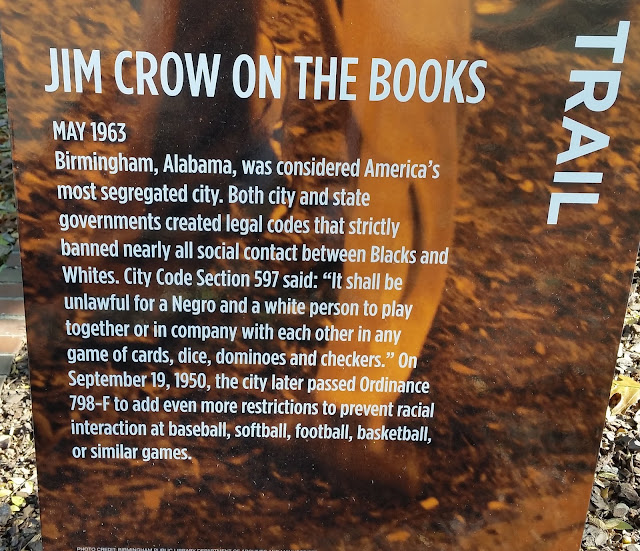Another move. This time from Chattanooga, Tennessee to Birmingham,
Alabama (180 miles/290 km).
And another look into history.
Our trip to Birmingham, Alabama, was dedicated to trying to learn more about the civil rights movement (borgerrettighedsbevægelsen).
It started with the constitution (grundloven) in 1789, that “All men are created equal….."
It was not over at the end of the civil war (borgerkrigen) in 1865, where slavery was abolished (afskaffet).
the freedom riders (both black and white students, who rode on buses from Washington DC to New Orleans),

the children and young people of Birmingham (who faced violence and being put in jail when they protested about segregation and voting rights), etc.
We went to a service (gudstjeneste) at the 16th Street Baptist Church. For two reasons. To experience another gospel service. These services are so different from what we are used to. Much more lively (the choir was doing such a good job that the parishioners (sognebørnene) called for an encore (extranummer) and they got it 😊 (we had never seen that before)).
It is our strong hope, that we and the rest of the world, will be able to adopt this pledge (løfte), that we found painted on a building in downtown Birmingham.
And another look into history.
Our trip to Birmingham, Alabama, was dedicated to trying to learn more about the civil rights movement (borgerrettighedsbevægelsen).
It started with the constitution (grundloven) in 1789, that “All men are created equal….."
It was not over at the end of the civil war (borgerkrigen) in 1865, where slavery was abolished (afskaffet).
After the civil war, a lot of the southern states passed apartheid laws (known
as the Jim Crow Laws) that segregated black and white people in all aspects of
life (Birmingham for instance had an ordinance (vedtægt) that prohibited (forbød)
black and white to even play cards or dominoes together). The black population was also, in practice, deprived of their right to vote.
Living in the small town of Watertown in Minnesota, Mary was not aware of how
people in the south lived, or anything about the civil rights movement in the
1960’s. She was not very old at the time. And places like Alabama were just as
far away for her as Europe. JJ, who grew up in the even smaller town of Rostrup,
Denmark, probably knew even less.
We have heard a lot about the historical events that took
place in Birmingham, Montgomery, and Selma, Alabama as adults. We have never
understood, how people could treat other people so badly. Mary: "I am sad that it
could happen, and I am ashamed on behalf of my countrymen. Today, I was
confirmed in both of these feelings. (And even more sad – discrimination still
exists☹)"
We were impressed by the wisdom and foresight of the leaders of the civil rights movement – people like Martin Luther King and Fred Shuttlesworth. They understood, that the movement would be most effective if it was non-violent. They taught protesters how to be forceful, without being violent. The people in power in the south didn’t know how to react to this. They used excessive violence, which made onlookers sympathize with the freedom fighters.
We were amazed at the courage of everyday people like Rosa
Parks (refused to give her seat up in a bus to a white man),
 |
| Rosa Parks |
the freedom riders (both black and white students, who rode on buses from Washington DC to New Orleans),

the children and young people of Birmingham (who faced violence and being put in jail when they protested about segregation and voting rights), etc.
 |
| "I ain't afraid of your jail" |
We were saddened by the misuse of power and violence, that
white people used against the black, to try to retain power. People like the
police commissioner in Birmingham – “Bull” Connor, or the group the Ku Klux
Klan.
 |
| Birmingham police dog |
We went to a service (gudstjeneste) at the 16th Street Baptist Church. For two reasons. To experience another gospel service. These services are so different from what we are used to. Much more lively (the choir was doing such a good job that the parishioners (sognebørnene) called for an encore (extranummer) and they got it 😊 (we had never seen that before)).
We also went because the 16th Street Baptist Church
was the center for the protests in early 1963. In September 1963 it was bombed
by Ku Klux Klan.Four girls were killed in the blast. Two more died from injuries and many more
were severely injured .
What happened in Birmingham was important for the civil
rights movement, but like so many other changes in society it was not one action that changed
the world, but rather the sum of many incidents. The protests were going on all
over the south from the middle of the fifties and led to the passing of the Civil
Rights Act (anti diskriminations lov) in 1964.
 |
| From Martin Luther King's speech in Washington DC |
It is our strong hope, that we and the rest of the world, will be able to adopt this pledge (løfte), that we found painted on a building in downtown Birmingham.
Written by Mary and JJ
















No comments:
Post a Comment